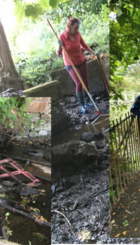- Cards
- List
.png)
Bothlin Burn Restoration and Climate Resilience Project
2022-10-27 • 4 comments • • Riverwoods 'Investment Readiness' Pioneers
Why our rivers?
The race to climate resilience, protecting our communities from climate breakdown, will be won or lost on rivers – and right now we're losing.
Damage to river systems has been so extensive that an urgent need has emerged, not only to conserve, but to restore these systems. Our degraded rivers are less able to cope with the rain we expect in the future, making flooding more likely to impact communities River rand riparian habitat restoration is an important measure to mitigate against these effects. Heavily modified rivers are often less resilient and have lost their ability to hold water in both droughts and floods.
Rivers are the veins of the Earth, transporting the water and nutrients needed to support the planet’s ecosystems, including human life. Unfortunately, they’re still threatened.
We must commit to recovering freshwater biodiversity, restoring natural river flows and cleaning up polluted water for people and nature to thrive.
Fish, amphibians, birds, insects, and invertebrates live in rivers, or find their food there. Rivers play a vital role in connecting habitats, and their value to plants and animals extends far beyond the surface area they cover.
Carbon starts its journey downstream when natural acid rain (which contains dissolved carbon dioxide from the atmosphere) dissolves minerals in rocks. This neutralises the acid and transforms carbon dioxide to bicarbonate in the water that then flows in our rivers. Bicarbonate can remain in water for thousands of years. (BBC)
Why Our River?
The Bothlin burn as it runs through the ancient woodland of the Moodiesburn Glen which sereates the communities of Moodiesburn and Chryston is a significant tribuary to the Luggie water and thereafter the clyde, restoring the river and riparian environment here has the capacity to bring multiple wins in tersm of biodiversity, community wellbeing, climate resilience, active travel, combatting health inequalites, improving community cohesion and restoration of fish populations. The burn being a positive contribution to the local environment rather than a polluted detrimental hazard is incredibly important to the surrounding communities who have expereinced an overwhelming loss of local greenspace which is essential to combat systemic health inequalities.
https://www.facebook.com/groups/NCCVols/permalink/2423176711147985/
Creating Climate Resilient Rivers in the Northern DSFB Region
2022-10-31 • 2 comments • • Riverwoods 'Investment Readiness' Pioneers
We wish to appoint a consultant to scope the opportunity for riparian tree planting within the Northern District Salmon Fishery Board area. Data shows that water temperatures are rising in rivers in the NDFSB region, threatening their delicate ecosystems. Riparian tree planting may help to address this issue, as well as offering other benefits.
The main roles for this 2-year contract will include:
- Scoping opportunities for riparian planting within the NDSFB
- Mapping suitable areas and preparing a budget for planting and maintenance
- Identifying funding streams
- Working with other organisations to deliver maximum benefit
The project will help to ensure that the salmon rivers of the Far North are better protected from the threat of rising water temperatures associated with climate change. The Northern DSFB covers some 1,000km2, much of which is located within the environmentally important Flow Country which is currently bidding for World Heritage Site status.
